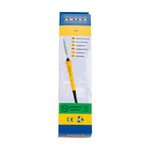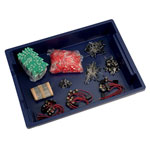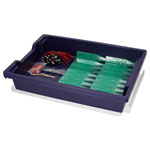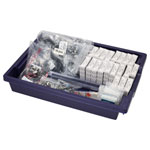
70-0054
- RoHS Compliant
- Country of Origin: United Kingdom
Discontinued
A kit of parts to make a circuit that continuously flashes 2 LEDs alternately.
In electronics it is often required to have a circuit that creates a continuous series of pulses (like the second hand on a clock which ticks every second). Examples of where this is useful include: digital clocks (to track time) and computers - the CPU needs to be triggered by pulses. Most digital systems usually require a central 'clock' that synchronises all the various parts.
A circuit which produces a pulse every so often is called an oscillator. Once powered, an oscillator's output will turn on and then turn off. Once this cycle has been completed it repeats itself indefinitely as long as there is power.
But how is an oscillator made? How do you get some components to keep on pulsing? With this kit you will be creating an circuit that uses two transistors and a few other components to create an oscillator that generates a few pulses every second so that it flashes LEDs (that is why it is called a flasher).
- Component count: 12
- Includes high quality printed circuit board (PCB)
- Downloadable Electronics Construction Manual includes sections on how to solder and how to identify and mount all types of components on to the printed circuit board
- Downloadable instructions include information specific to this kit including circuit diagrams, schematic diagrams and explanations, 'how it works' circuit descriptions as well as component identification and constructional notes
- Requires 1x PP3, 9V battery, not included
Supplied as a kit of parts for assembly. Soldering is required.
| Type | Flasher module |
|---|---|
| Power | 9V |
| Range | N/A |
| Soldering | Yes |











